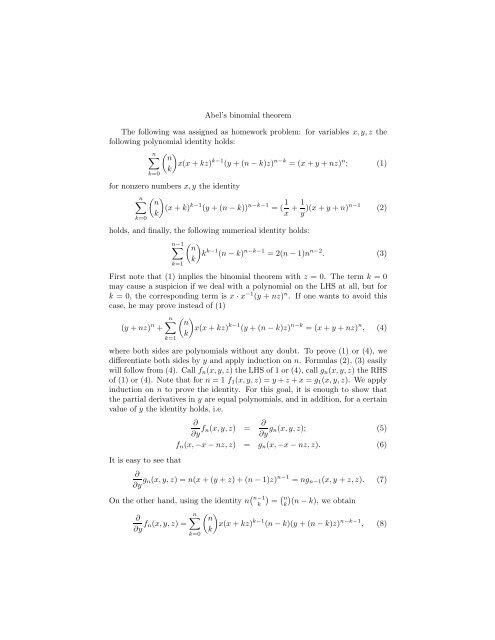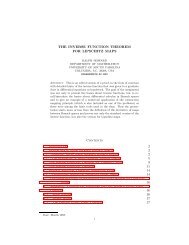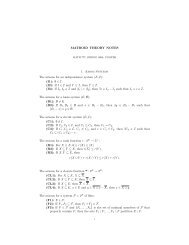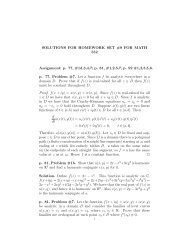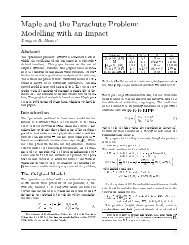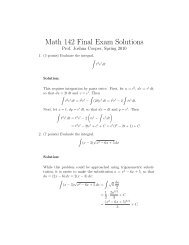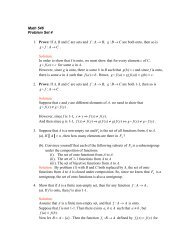Abel's binomial theorem The following was assigned as homework ...
Abel's binomial theorem The following was assigned as homework ...
Abel's binomial theorem The following was assigned as homework ...
You also want an ePaper? Increase the reach of your titles
YUMPU automatically turns print PDFs into web optimized ePapers that Google loves.
Abel’s <strong>binomial</strong> <strong>theorem</strong><br />
<strong>The</strong> <strong>following</strong> <strong>w<strong>as</strong></strong> <strong><strong>as</strong>signed</strong> <strong>as</strong> <strong>homework</strong> problem: for variables x, y, z the<br />
<strong>following</strong> polynomial identity holds:<br />
n�<br />
� �<br />
n<br />
x(x + kz)<br />
k<br />
k−1 (y +(n−k)z) n−k =(x+y+nz) n ; (1)<br />
k=0<br />
k=0<br />
for nonzero numbers x, y the identity<br />
n�<br />
� �<br />
n<br />
(x + k)<br />
k<br />
k−1 (y +(n−k)) n−k−1 =( 1<br />
x +1)(x<br />
+ y + n)n−1<br />
y<br />
holds, and finally, the <strong>following</strong> numerical identity holds:<br />
n−1 �<br />
� �<br />
n<br />
k<br />
k<br />
k−1 (n − k) n−k−1 =2(n−1)n n−2 . (3)<br />
k=1<br />
k=1<br />
First note that (1) implies the <strong>binomial</strong> <strong>theorem</strong> with z =0. <strong>The</strong>termk=0<br />
may cause a suspicion if we deal with a polynomial on the LHS at all, but for<br />
k = 0, the corresponding term is x · x−1 (y + nz) n . If one wants to avoid this<br />
c<strong>as</strong>e, he may prove instead of (1)<br />
(y + nz) n n�<br />
� �<br />
n<br />
+ x(x + kz)<br />
k<br />
k−1 (y +(n−k)z) n−k =(x+y+nz) n , (4)<br />
where both sides are polynomials without any doubt. To prove (1) or (4), we<br />
differentiate both sides by y and apply induction on n. Formul<strong>as</strong> (2), (3) e<strong>as</strong>ily<br />
will follow from (4). Call fn(x, y, z) the LHS of 1 or (4), call gn(x, y, z) the RHS<br />
of (1) or (4). Note that for n =1f1(x, y, z) =y+z+x=g1(x, y, z). We apply<br />
induction on n to prove the identity. For this goal, it is enough to show that<br />
the partial derivatives in y are equal polynomials, and in addition, for a certain<br />
value of y the identity holds, i.e.<br />
∂<br />
∂y fn(x, y, z) = ∂<br />
∂y gn(x, y, z); (5)<br />
fn(x, −x − nz, z) = gn(x, −x − nz, z). (6)<br />
It is e<strong>as</strong>y to see that<br />
∂<br />
∂y gn(x, y, z) =n(x+(y+z)+(n−1)z) n−1 = ngn−1(x, y + z,z). (7)<br />
On the other hand, using the identity n � � � � n−1 n<br />
k = k (n − k), we obtain<br />
∂<br />
∂y fn(x,<br />
n�<br />
� �<br />
n<br />
y, z) = x(x + kz)<br />
k<br />
k−1 (n − k)(y +(n−k)z) n−k−1 , (8)<br />
k=0<br />
(2)
n−1 �<br />
� �<br />
n − 1<br />
= n<br />
x(x+kz)<br />
k<br />
k=0<br />
k−1 [(y+z)+((n−1)−k)z] (n−1)−k = nfn−1(x, y+z,z).<br />
(9)<br />
It follows from the induction hypothesis that<br />
nfn−1(x, y + z,z) =ngn−1(x, y + z,z),<br />
and this finishes the proof of (5). We turn to the proof of (6). This will be proved<br />
much like in the manner of the proof to (5). Since obviously gn(x, −x−nz, z) =<br />
0, we have to prove fn(x, −x − nz, z) = 0. We are going to do it by induction<br />
on n. <strong>The</strong> b<strong>as</strong>e c<strong>as</strong>e is trivial again. We have to prove the <strong>following</strong> two facts:<br />
Let us start with<br />
To verify (10),<br />
fn(x, −x − nz, z) =<br />
∂<br />
∂z fn(x, −x − nz, z) = 0; (10)<br />
fn(x, −x, 0) = 0. (11)<br />
n�<br />
k=0<br />
∂<br />
∂z fn(x, −x − nz, z)=(n−1)<br />
(using k � � � � n n−1<br />
k = n k−1 for k>0)<br />
= n(n − 1)<br />
j=0<br />
n�<br />
k=1<br />
� �<br />
n<br />
(−1)<br />
k<br />
n−k x(x + kz) n−1 .<br />
n�<br />
k=0<br />
� �<br />
n<br />
xk(−1)<br />
k<br />
n−k (x + kz) n−2<br />
� �<br />
n − 1<br />
x(−1)<br />
k − 1<br />
n−k (x + kz) n−2<br />
n−1 �<br />
� �<br />
n − 1<br />
= n(n − 1)<br />
x(−1)<br />
j<br />
n−1−j (x +(j+1)z) n−2 . (12)<br />
We have to show that (12) is equal to zero. Use the hypothesis<br />
to prove<br />
0=fn−1(x, −x, −(n − 1)z,z)<br />
n−1 �<br />
0= (−1) n−1−j<br />
� �<br />
n − 1<br />
x(x + jz)<br />
j<br />
n−2 . (13)<br />
j=0<br />
Substitute in (13) x + z to the place of x and multiply the resulting formula by<br />
x/(x + z) to obtain that (12) is equal to zero.<br />
2
<strong>The</strong> proof of (11) is trivial, since<br />
fn(x, −x, 0) = x n<br />
n�<br />
k=0<br />
� �<br />
n<br />
(−1)<br />
k<br />
n−k =0,<br />
because of the rule on the summation of <strong>binomial</strong> coefficients with alternating<br />
sign in a row of the P<strong>as</strong>cal triangle.<br />
An alternative proof of (6) goes in a more direct way but uses a b<strong>as</strong>ic<br />
inclusion-exclusion result:<br />
n�<br />
� �<br />
n<br />
fn(x, −x − nz, z) =x (−1)<br />
k<br />
n−k (x + kz) n−1<br />
k=0<br />
n�<br />
� �<br />
n<br />
= x (−1)<br />
k<br />
k=0<br />
n−k<br />
n−1 �<br />
� �<br />
n − 1<br />
k<br />
j<br />
j=0<br />
j z j x n−j n−1 �<br />
= x x<br />
j=0<br />
n−j z j<br />
n�<br />
� �<br />
n<br />
(−1)<br />
k<br />
k=0<br />
n−k k j .<br />
Note that for j < n natural number �n � � n n−k j<br />
k=0 k (−1) k =thenumberof<br />
surjections from an j-element set to an n-element set, and hence is zero.<br />
Turning to the proof of (2), apply (1) with z =1:<br />
n�<br />
� �<br />
n<br />
fn(x, y, 1) = x(x + k)<br />
k<br />
k=0<br />
k−1 (y + n − k) n−k−1 (y + n − k) (14)<br />
n�<br />
� �<br />
n<br />
= x(x + k)<br />
k<br />
k=0<br />
k−1 y(y + n − k) n−k−1<br />
(15)<br />
n�<br />
� �<br />
n<br />
+ x(x + k)<br />
k<br />
k=0<br />
k−1 (y + n − k) n−k−1 (n − k). (16)<br />
Here, using � � � � n<br />
n−1<br />
k (n − k) =n k for k ≤ n − 1, we have that (15) is equal to<br />
n−1 �<br />
� �<br />
n − 1<br />
n x(x + k)<br />
k<br />
k−1 ((y +1)+(n−1) − k) (n−1)−k<br />
k=0<br />
= nfn−1(x, y +1,1) = n(x + y + n) n−1 .<br />
Since fn(x, y, 1) = (x + y + n) n , (14,15,16) imply that (16) is equal to<br />
(x + y + n) n − n(x + y + n) n−1 =(x+y)(x + y + n) n−1 .<br />
Dividing by xy yields the required identity (2).<br />
Finally, in order to prove (3), subtract<br />
1<br />
x (y + n)n−1 + 1<br />
(x + n)n−1<br />
y<br />
3
from both sides of (2). We get<br />
n−1 �<br />
� �<br />
n<br />
x(x + k)<br />
k<br />
k−1 (y + n − k) n−k−1 =<br />
k=1<br />
1<br />
x [(x + y + n)n−1 − (y + n) n−1 ]+ 1<br />
y [(x + y + n)n−1 − (x + n) n−1 ].<br />
Taking the limit when x, y → 0 we obtain the LHS of (1) on the LHS by<br />
continuity, on the RHS we have<br />
1<br />
lim<br />
x→0 x [(x + y + n)n−1 − (y + n) n−1 ]= d<br />
dx (x + y + n)n−1 |x=0 =(n−1)(y + n) n−2 ,<br />
and by continuity limy→0(n − 1)(y + n) n−2 =(n−1)nn−2 . Another (n − 1)nn−2 comes from the other term in the RHS. We proved (3).<br />
We mention here, that Abel’s <strong>binomial</strong> <strong>theorem</strong> h<strong>as</strong> been further genereralized<br />
by Hurwitz into the <strong>following</strong> polynomial identity in variables x, y, z1, ..., zn:<br />
Hurwitz’ Binomial <strong>The</strong>orem:<br />
�<br />
n�<br />
x(x +<br />
ɛi=0,1<br />
i=1<br />
�n ɛizi) i=1 ɛi−1 (y +<br />
n�<br />
i=1<br />
(1 − ɛi)zi) n−� n<br />
i=1 ɛi =<br />
(x + y + z1 + ... + zn) n ;<br />
or, in alternative description, corresponding to (2), we have<br />
�<br />
ɛi=0,1<br />
x(x +<br />
n�<br />
i=1<br />
�n ɛizi) i=1 ɛi−1 y(y +<br />
n�<br />
i=1<br />
(1 − ɛi)zi) n−1−� n<br />
i=1 ɛi =<br />
(x + y)(x + y + z1 + ... + zn) n−1 .<br />
<strong>The</strong> summation means 2n terms. <strong>The</strong> simplest proof of Hurwitz’ Binomial<br />
<strong>The</strong>orem — what a surprise! — goes by counting trees. It is an e<strong>as</strong>y to see how<br />
Hurwitz’ Binomial <strong>The</strong>orem implies Abel’s Binomial <strong>The</strong>orem. You may note<br />
that the second version of Hurwitz’ Binomial <strong>The</strong>orem generalizes a version of<br />
(2), where both sides are multiplied by xy. Hence (2) also h<strong>as</strong> a polynomial<br />
identity version:<br />
n�<br />
� �<br />
n<br />
x(x + k)<br />
k<br />
k−1 y(y +(n−k)z) n−k−1 =(x+y)(x + y + nz) n−1 .<br />
k=0<br />
<strong>The</strong>re is a subtle point here that h<strong>as</strong> to be mentioned. What we really<br />
proved is that (1) holds for all real values of x, y, z, but we have not proved the<br />
4
polynomial identity yet. By definition, polynomial identity means that for all<br />
α, β, γ the coefficients of x α y β z γ are identical in the RHS and in the LHS of<br />
(1). However, the <strong>following</strong> <strong>theorem</strong> holds:<br />
<strong>The</strong>orem If f(x1,x2, ..., xn) andg(x1,x2, ..., xn) are multivariate polynomials,<br />
so that we have infinite sets A1,A2, ..., An such that f(a1,a2, ..., an) =<br />
g(a1,a2, ..., an) whenever ai ∈ Ai, thenf(x1,x2, ..., xn) =g(x1,x2, ..., xn) <strong>as</strong><br />
polynomials.<br />
You know this <strong>theorem</strong> for n = 1 from elementary algebra: two different<br />
polynomials of degree at most d can agree in at most d places. <strong>The</strong> proof of the<br />
<strong>theorem</strong> goes by induction on n. Write<br />
f(x1,x2, ..., xn) = �<br />
and<br />
α<br />
g(x1,x2, ..., xn) = �<br />
α<br />
fα(x1,x2, ..., xn−1)x α n<br />
gα(x1,x2, ..., xn−1)x α n .<br />
We are going to show that for all ai ∈ Ai (i =1,2, ..., n − 1) and all α,<br />
fα(a1,a2, ..., an−1) =gα(a1,a2, ..., an−1).<br />
Using the hypothesis for n − 1, we obtain that for all α,<br />
fα(x1,x2, ..., xn−1) =gα(x1,x2, ..., xn−1)<br />
<strong>as</strong> polynomials, and this will imply the <strong>theorem</strong>.<br />
and<br />
Fix ai ∈ Ai in an arbitrary way. Define the single variable polynomials<br />
f ∗ (xn) = �<br />
α<br />
g ∗ (xn) = �<br />
fα(a1,a2, ..., an−1)x α n<br />
gα(a1,a2, ..., an−1)x α n.<br />
α<br />
Polynomials f ∗ and g∗ agree on infinetely many places for xn (namely, on the<br />
elements of An), and therefore by the n = 1 b<strong>as</strong>e c<strong>as</strong>e these polynomials are<br />
identical polynomials, i.e. agree termwise, hence<br />
holds.<br />
fα(a1,a2, ..., an−1) =gα(a1,a2, ..., an−1)<br />
5


